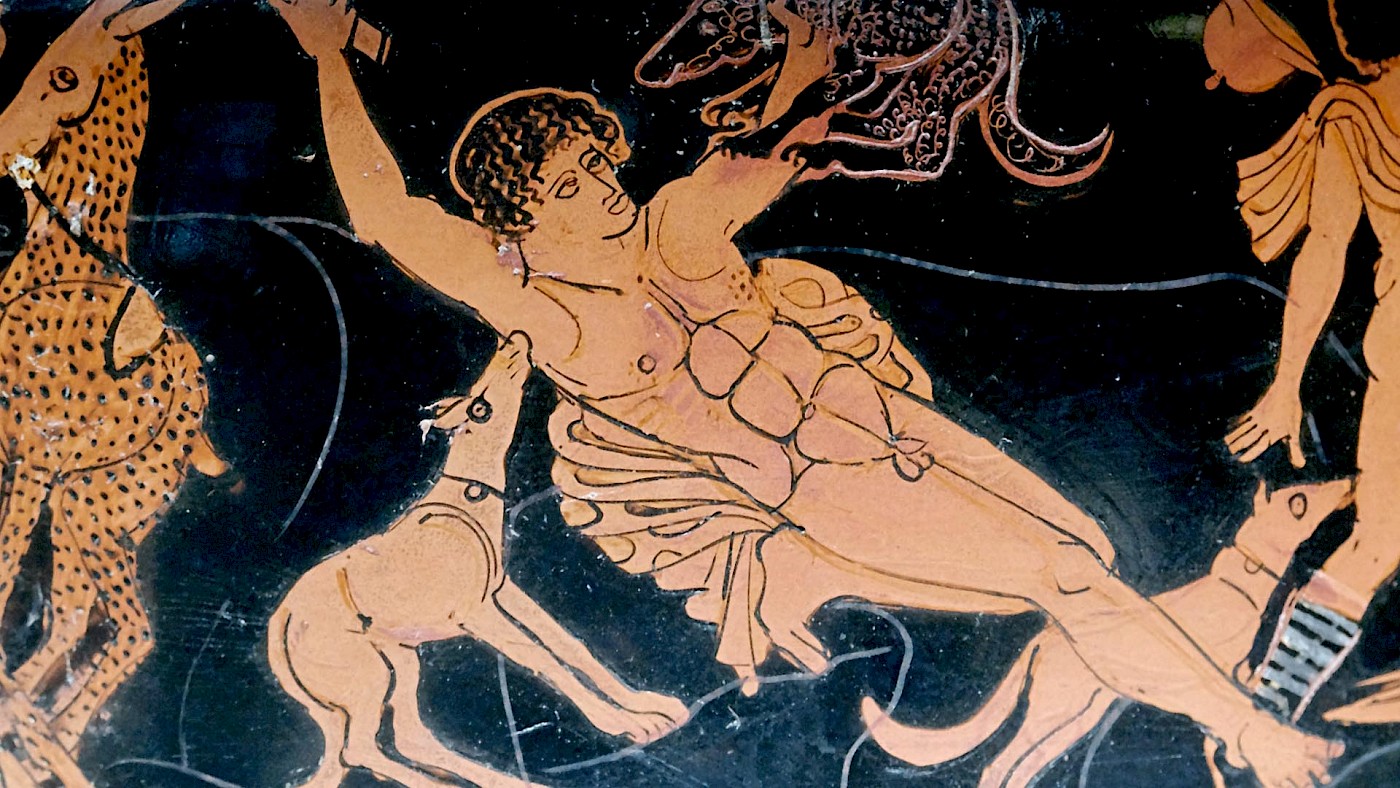Actaeon was the son of Autonoe, who was herself a daughter of Cadmus. Cadmus was a Phoenician prince who had travelled to Greece in search of his sister Europa, who had been kidnapped by Zeus. When he failed to find her, he settled in Boeotia, founding the city of Thebes.
The genealogical poem Ehoiai, attributed to the Boeotian poet Hesiod (a contemporary of Homer), gives a very brief summary of Actaeon’s life: he was mistreated by his grandfather (presumably Cadmus) and was at some point turned into a stag by the goddess Artemis, and in this guise killed by his own dogs.
A gruesome fate
Just what did Actaeon do that was so bad that he had to be ripped apart by his own hounds? The version of the story that we’re most familiar with, thanks to Ovid’s Metamorphoses (book 3), is that Actaeon was hunting on Mount Cithaeron (located on the border between Boeotia and Attica) when he accidentally happened upon Artemis – referred to as Diana among the Romans – bathing with her nymphs.
Artemis, the goddess of the hunt, twin sister of Apollo, was a virgin goddess, who didn’t take kindly to a mortal seeing her naked form, even if just by accident. Like the other Olympian gods, Artemis was quick to anger: in a rage, she turned the poor Actaeon into a stag, and he was subsequently chased by his own hounds and killed. (In ancient art, Actaeon is often depicted in human form when he’s shown attacked by his dogs or, in one instance, as a human with the head of a stag.)
Diodorus Siculus, a Greek historian of the first century BC, suggests two different reasons for the goddess’ anger (4.81.4-5). According to him, some claimed that Actaeon had wished to marry the goddess, went to her temple for this purpose, and that she killed him for this act of arrogance. Others, he writes, suggest that Artemis was angered when Actaeon boasted that he was a better hunter than she was.
However, there’s evidence for another, earlier version of the story that gives a far more interesting reason for Actaeon’s punishment. There are hints of this in the fragmentary Hesiodic Ehoiai. The more complete source is Stesichorus (Timothy Gantz, Early Greek Myth (1993), p. 478), who was active in the first half of the sixth century BC. According to this lyric poet, Actaeon had wanted to marry Semele, his mother’s younger sister. While incest was common among the gods (for example, Zeus married his sister Hera), it was taboo among mortals.
Furthermore, Zeus had taken a fancy to Semele. Naturally, the “father of gods and men”, as Zeus was often referred to, would not have tolerated a mortal to compete with him for her affections. So it’s possible that Zeus retaliated by transforming Actaeon into a stag, to be chased and killed by his own hounds. After all, such feats of transformation weren’t out of the ordinary: Zeus once transformed another of his mortal lovers, Io, into a cow to hide her from Hera.
It’s possible that Zeus might not have wanted to dirty his hands. Instead, he might have sent Artemis to punish Actaeon. Certainly, Artemis had donned the guise of an assassin before, when she and her brother Apollo had been instructed by their mother Leto to punish the unfortunate Niobe. The latter had boasted about her children and claimed she was a greater mother than Leto because her offspring were more plentiful. To teach her a lesson, Artemis and Apollo shot and killed all of Niobe’s children.
Closing remarks
Each of the different versions of the story of Actaeon paint a different picture of the man’s character. In what is perhaps the oldest version of the tale, he was in love with his aunt, which brought him into direct conflict with Zeus and, perhaps according to the Ehoiai, his grandfather, who was probably none too happy about his grandson making overtures to his daughter. (The familial intrigue and love triangle would have made for excellent tragedies, but unfortunately the plays about Actaeon that circulated in the early fifth century BC survive in too fragmentary a state to say much about them.)
In other versions of the tale, Actaeon was punished either because of boasting about his hunting prowess or because he was simply in the wrong place at the wrong time. It’s the latter version of the story where he seems the most sympathetic perhaps, but it’s also, in my opinion, the least interesting take. But like the ancient Greeks themselves, we’re free to pick and chose which of the different stories to retell.
While all of the different versions of the story are clearly supernatural, the ancient Greeks nevertheless believed that some traces of the tale had been preserved in physical form. Pausanias, who lived in the second century AD and wrote a guide to Greece, noted that Autonoe’s tomb could be found at Erenia in the Megarid. She had gone to this village following Actaeon’s death (1.44.5). He also notes that there’s a rock on the road to Megara that was known as Actaeon’s Bed. This was supposedly the place where the hunter rested before he crossed paths with Artemis (9.2.3).
